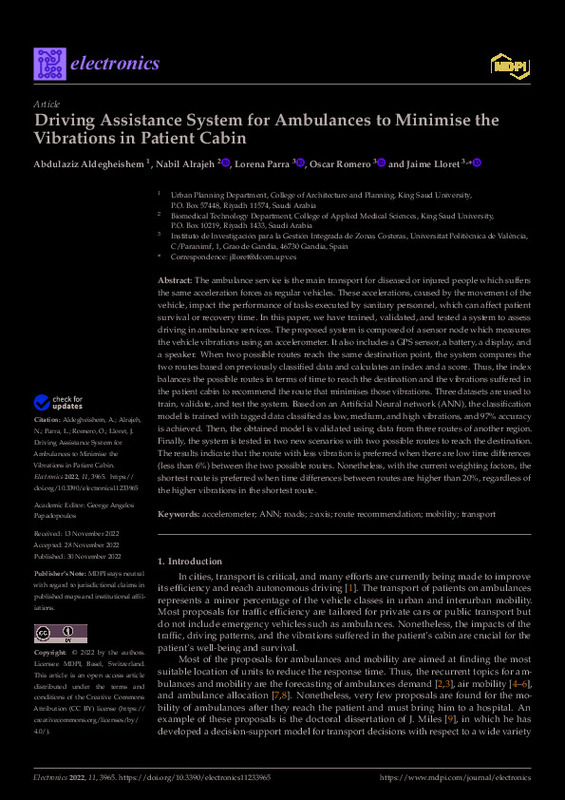JavaScript is disabled for your browser. Some features of this site may not work without it.
Buscar en RiuNet
Listar
Mi cuenta
Estadísticas
Ayuda RiuNet
Admin. UPV
Driving Assistance System for Ambulances to Minimise the Vibrations in Patient Cabin
Mostrar el registro sencillo del ítem
Ficheros en el ítem
| dc.contributor.author | Aldegheishem, Abdulaziz
|
es_ES |
| dc.contributor.author | Alrajeh, Nabil
|
es_ES |
| dc.contributor.author | Parra, Lorena
|
es_ES |
| dc.contributor.author | Romero Martínez, José Oscar
|
es_ES |
| dc.contributor.author | Lloret, Jaime
|
es_ES |
| dc.date.accessioned | 2023-11-28T19:02:08Z | |
| dc.date.available | 2023-11-28T19:02:08Z | |
| dc.date.issued | 2022-12 | es_ES |
| dc.identifier.uri | http://hdl.handle.net/10251/200290 | |
| dc.description.abstract | [EN] The ambulance service is the main transport for diseased or injured people which suffers the same acceleration forces as regular vehicles. These accelerations, caused by the movement of the vehicle, impact the performance of tasks executed by sanitary personnel, which can affect patient survival or recovery time. In this paper, we have trained, validated, and tested a system to assess driving in ambulance services. The proposed system is composed of a sensor node which measures the vehicle vibrations using an accelerometer. It also includes a GPS sensor, a battery, a display, and a speaker. When two possible routes reach the same destination point, the system compares the two routes based on previously classified data and calculates an index and a score. Thus, the index balances the possible routes in terms of time to reach the destination and the vibrations suffered in the patient cabin to recommend the route that minimises those vibrations. Three datasets are used to train, validate, and test the system. Based on an Artificial Neural network (ANN), the classification model is trained with tagged data classified as low, medium, and high vibrations, and 97% accuracy is achieved. Then, the obtained model is validated using data from three routes of another region. Finally, the system is tested in two new scenarios with two possible routes to reach the destination. The results indicate that the route with less vibration is preferred when there are low time differences (less than 6%) between the two possible routes. Nonetheless, with the current weighting factors, the shortest route is preferred when time differences between routes are higher than 20%, regardless of the higher vibrations in the shortest route. | es_ES |
| dc.description.sponsorship | This work was supported by the Researchers Supporting Project number (RSP-2021/295), King Saud University, Riyadh, Saudi Arabia. | es_ES |
| dc.language | Inglés | es_ES |
| dc.publisher | MDPI AG | es_ES |
| dc.relation.ispartof | Electronics | es_ES |
| dc.rights | Reconocimiento (by) | es_ES |
| dc.subject | Accelerometer | es_ES |
| dc.subject | ANN | es_ES |
| dc.subject | Roads | es_ES |
| dc.subject | Z-axis | es_ES |
| dc.subject | Route recommendation | es_ES |
| dc.subject | Mobility | es_ES |
| dc.subject | Transport | es_ES |
| dc.subject.classification | INGENIERÍA TELEMÁTICA | es_ES |
| dc.title | Driving Assistance System for Ambulances to Minimise the Vibrations in Patient Cabin | es_ES |
| dc.type | Artículo | es_ES |
| dc.identifier.doi | 10.3390/electronics11233965 | es_ES |
| dc.relation.projectID | info:eu-repo/grantAgreement/KSU//RSP-2021%2F295//Researchers Supporting Project/ | es_ES |
| dc.rights.accessRights | Abierto | es_ES |
| dc.contributor.affiliation | Universitat Politècnica de València. Instituto de Investigación para la Gestión Integral de Zonas Costeras - Institut d'Investigació per a la Gestió Integral de Zones Costaneres | es_ES |
| dc.contributor.affiliation | Universitat Politècnica de València. Escuela Técnica Superior de Ingenieros de Telecomunicación - Escola Tècnica Superior d'Enginyers de Telecomunicació | es_ES |
| dc.contributor.affiliation | Universitat Politècnica de València. Escuela Politécnica Superior de Gandia - Escola Politècnica Superior de Gandia | es_ES |
| dc.description.bibliographicCitation | Aldegheishem, A.; Alrajeh, N.; Parra, L.; Romero Martínez, JO.; Lloret, J. (2022). Driving Assistance System for Ambulances to Minimise the Vibrations in Patient Cabin. Electronics. 11(23):1-19. https://doi.org/10.3390/electronics11233965 | es_ES |
| dc.description.accrualMethod | S | es_ES |
| dc.relation.publisherversion | https://doi.org/10.3390/electronics11233965 | es_ES |
| dc.description.upvformatpinicio | 1 | es_ES |
| dc.description.upvformatpfin | 19 | es_ES |
| dc.type.version | info:eu-repo/semantics/publishedVersion | es_ES |
| dc.description.volume | 11 | es_ES |
| dc.description.issue | 23 | es_ES |
| dc.identifier.eissn | 2079-9292 | es_ES |
| dc.relation.pasarela | S\491786 | es_ES |
| dc.contributor.funder | King Saud University | es_ES |








